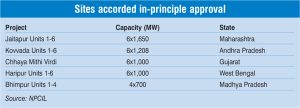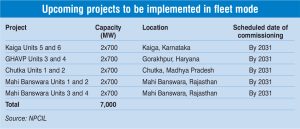
India’s power sector is striving to achieve the twin objectives of meeting the growing power demand in the country and decarbonising the sector. Nuclear power, backed by high availability and continuous generation, is fast emerging as a key option for delivering clean baseload power in the country. Characterised by competitive tariffs and being a clean and reliable energy source, nuclear power stands to play an important role in the energy security of the country. Notably, India’s Long-term Low Carbon Development Strategy submitted to the United Nations Framework Convention on Climate Change at the COP27 summit takes cognisance of the vital role of nuclear power in climate change mitigation. It aims to explore a greater role for nuclear energy in the country’s energy mix and achieve a threefold increase in nuclear installed capacity by 2032.
“The need for nuclear power is imminent. It has been variously indicated that over the next 50 years, India will grow to become the second-largest economy in the world. Over the next 20-25 years in particular, we will likely witness high economic growth due to the various tailwinds including demographics, geopolitics, innovative nature of Indian society and the democratic (along with demographic) dividend. Growth is energy hungry. Our energy needs will have to be met from the available options. While India’s coal plants are likely to continue, new coal-fired plants are going to be increasingly difficult to finance or build unless cost-effective means for CO2 abatement are found. Renewables will grow fast, but will struggle to meet the large demand growth, apart from the challenges in variability management. Commodities such as green hydrogen, for which India has ambitious plans, will place further demands. Hence, India needs alternative reliable baseload or load following capacity on a very large scale. Nuclear has to be a key part of the future power fleet to cater to these emerging needs,” says Anish De, global head of energy and natural resources, KPMG.
Notably, after a long hiatus, the nuclear power segment is now gaining attention from policymakers and developers. The indigenous development of 10 reactors in fleet mode, approved in 2017, is expected to start in a couple of months. Besides this, NTPC Limited reportedly aims to install 20 GW of nuclear power capacity by 2050 and is working on a comprehensive roadmap for nuclear power generation in the country.
Current scenario – Installed capacity and operational performance
While India commissioned its first nuclear power plant, the Tarapur Atomic Power Station, way back in 1969, growth in nuclear power capacity has been slow since. India has an installed capacity of 6,780 MW across 22 reactors owned by Nuclear Power Corporation of India Limited (NPCIL), which is 100 per cent owned by the Government of India and operates under the administrative control of the Department of Atomic Energy (DAE). Post 2017, no new reactor has been added. Technology-wise, all the nuclear plants operate on pressurised heavy water reactors (PHWRs), except the Tarapur Atomic Power Station, which is based on boiler water reactors.
In terms of the energy mix, nuclear power accounts for only 2 per cent of the total installed capacity. During 2022-23, around 45 BUs of power was generated from nuclear plants, accounting for a 3 per cent share. With the progressive commissioning of nuclear reactors and enhanced availability of fuel, power generation from nuclear reactors has increased at a CAGR of 4 per cent from 2010-11 to 2022-23.
The nuclear power plants have over the years maintained high capacity and availability factors. During 2022-23, the capacity and availability factors of NPCIL’s power plants were recorded at 87 per cent each and have consistently been over 80 per cent since 2019-20. Overall, the high availability and capacity factors of NPCIL’s power plants are supported by adequate fuel tie-ups with domestic and international players, as well as must-run status for nuclear power plants and competitive tariffs.
Upcoming capacity
 A cumulative nuclear power capacity of 8,200 MW is currently under construction by NPCIL. These include Kakrapar Unit 4, Rajasthan Units 7 and 8, Kudankulam Units 3 and 4, Kudankulam Units 5 and 6, and Gorakhpur Units 1 and 2. While the majority of the existing and under-construction nuclear power plants are located in the southern and western regions, Gorakhpur Haryana Anu Vidyut Pariyojana’s (GHAVP) two units of 700 MWe each, based on indigenous PHWR design, at Gorakhpur village in Fatehabad district in Haryana will be north India’s first nuclear power plant.
A cumulative nuclear power capacity of 8,200 MW is currently under construction by NPCIL. These include Kakrapar Unit 4, Rajasthan Units 7 and 8, Kudankulam Units 3 and 4, Kudankulam Units 5 and 6, and Gorakhpur Units 1 and 2. While the majority of the existing and under-construction nuclear power plants are located in the southern and western regions, Gorakhpur Haryana Anu Vidyut Pariyojana’s (GHAVP) two units of 700 MWe each, based on indigenous PHWR design, at Gorakhpur village in Fatehabad district in Haryana will be north India’s first nuclear power plant.
Apart from this, Bharatiya Nabhikiya Vidyut Nigam Limited (BHAVINI), a government company under the administrative control of the DAE, is constructing the first 500 MWe fast breeder reactor at Kalpakkam in Tamil Nadu. Another 10 nuclear reactors of 700 MWe each, to be developed indigenously in fleet mode, are expected to be commissioned by 2031. Further, the government has accorded in-principle approval for five new sites for setting up nuclear power parks aggregating over 30 GW of capacity in the future. Pre-project activities at the new sites, for which in-principle approval by the Government of India has been accorded, have been initiated so as to enable the early launch of projects.
Overall, with the progressive completion of projects (under construction and sanctioned), the installed nuclear power capacity is set to increase from 6,780 MW to 22,480 MW by 2031.
Indigenous PHWR
In a key milestone for nuclear power development in the country, the largest domestically built nuclear reactor – the 700 MWe Unit 3 of the Kakrapar Atomic Power Project located at Kakrapar, Gujarat – was connected to the grid in 2021 and is expected to start commercial operations soon. The components and equipment for the reactor have been manufactured domestically, and project construction and erection have been undertaken by various Indian contractors.
Notably, India plans to scale up its domestic manufacturing of nuclear power generators significantly to achieve its nuclear power plans. In 2017, the central government accorded approval and financial sanctions for the construction of 10 indigenously designed PHWRs as a fully home-grown initiative. These reactors are scheduled to be built at fourmplant locations by 2031 at a cost of Rs 1,050 billion. The materials, components and components and equipment needed to build the 10 units will be sourced indigenously. The reactors will be developed in fleet mode to bring economies of scale and maximise efficiency, thereby reducing costs and speeding up construction time. With the first pour of concrete (FPC), which signals the beginning of construction of nuclear power reactors from the pre-project stage, for a 700 MW atomic power plant in Karnataka’s Kaiga scheduled in 2023, India is set to put in motion construction activities for 10 fleet mode nuclear reactors over the next three years. Meanwhile, the FPC of Gorakhpur Haryana Anu Vidyut Praiyojana Units 3 and 4 and Mahi Banswara Rajasthan Atomic Power Projects Units 1 to 4 is expected in 2024, and that of Chutka Madhya Pradesh Atomic Power Project Units 1 and 2 in 2025. Further, in order to produce fuel for the indigenous PHWRs and match the requirements of the existing and upcoming reactors, fuel fabrication capacity augmentation is under way at the Nuclear Fuel Complex in Hyderabad and at NGC in Kota.
In 2017, the central government accorded approval and financial sanctions for the construction of 10 indigenously designed PHWRs as a fully home-grown initiative. These reactors are scheduled to be built at fourmplant locations by 2031 at a cost of Rs 1,050 billion. The materials, components and components and equipment needed to build the 10 units will be sourced indigenously. The reactors will be developed in fleet mode to bring economies of scale and maximise efficiency, thereby reducing costs and speeding up construction time. With the first pour of concrete (FPC), which signals the beginning of construction of nuclear power reactors from the pre-project stage, for a 700 MW atomic power plant in Karnataka’s Kaiga scheduled in 2023, India is set to put in motion construction activities for 10 fleet mode nuclear reactors over the next three years. Meanwhile, the FPC of Gorakhpur Haryana Anu Vidyut Praiyojana Units 3 and 4 and Mahi Banswara Rajasthan Atomic Power Projects Units 1 to 4 is expected in 2024, and that of Chutka Madhya Pradesh Atomic Power Project Units 1 and 2 in 2025. Further, in order to produce fuel for the indigenous PHWRs and match the requirements of the existing and upcoming reactors, fuel fabrication capacity augmentation is under way at the Nuclear Fuel Complex in Hyderabad and at NGC in Kota.
Efforts continue to be under way to enhance the domestic manufacturing capabilities of nuclear power reactors. A case in point is the recently signed MoU between NPCIL and Bharat Heavy Electricals Limited (BHEL) to jointly pursue opportunities in nuclear power plants based on PHWR technology. Under the MoU, BHEL and NPCIL will jointly explore opportunities for the development of nuclear power projects to reduce project gestation time.
NTPC’s plans
NTPC Limited plans to make a foray into nuclear power generation to accelerate the country’s efforts to achieve net zero emissions. It is preparing a comprehensive roadmap for nuclear generation considering the current generation size of the company as well as load growth and India’s net zero energy target for 2070. The roadmap will factor in both near-term and longer-term nuclear options that are best suited for India. In addition, it will address the needs of both the company and the Indian civil nuclear power industry to enable the transition to nuclear power and address issues such as training and development, licensing requirements for the new plants, nuclear export control considerations, civil nuclear liability status and development needs, operational and maintenance infrastructure to support a new fleet of reactors, as well as nuclear waste considerations. Additionally, NTPC is considering the development of nuclear technology such as light water reactors (LWRs), small modular reactors (SMRs), and advanced SMRs (Gen IV plants).
As per its initial plan, NTPC will reportedly start generating 2,000 MW of nuclear energy by 2032, 4,200 MW by 2035 and eventually scale up to 20,000 MW by 2050. Two nuclear power plants, with a total capacity of 4,200 MW, have been finalised so far. One project, with two units of 700 MW each, will be set up in Chutka, Madhya Pradesh. The second project, of 2,800 MW (4×700 MW) capacity, will be set up at Mahi Banswara in Rajasthan. The two plants will have PHWRs, which will be fully indigenised.
Apart from this, NTPC’s joint venture (JV) with NPCIL is exploring the possibility of entering into business activities related to nuclear power generation and front-end fuel at an appropriate stage. To recall, the 2016 amendment of the Atomic Energy Act, 1962 enabled JVs of NPCIL and public sector companies to set up and operate nuclear power projects. JV companies such as Anushakti Vidhyut Nigam Limited (NPCIL-NTPC Limited) and NPCIL-Indian Oil Nuclear Energy Corporation Limited (NPCIL-IOCL) have been incorporated, and various other public sector companies as well as Indian Railways have evinced interest in setting up JVs with NPCIL.
Future outlook
The government has set a target to achieve 9 per cent share of electricity from nuclear sources by 2047 and to commission nearly 20 GW of nuclear capacity by 2030. However, while India is inching towards achieving these goals, issues such as high upfront costs and adverse public perception are big hurdles. “Unfortunately, nuclear is beset with challenges,” says De. “There is a clear cost challenge since the current cost of development makes it unaffordable on a very large scale. These projects are also very prone to cost overruns. Secondly, there is a big issue of public perception regarding safety, which has to be overcome. Modern nuclear plants are much safer, but public perception remains adverse, especially after Fukushima. Thirdly, there is the issue of specialised skills for building these plants, which often causes delays and overruns. Fourth is the challenge of waste processing and management. There are also issues relating to civil liabilities, land acquisition, etc. However, to me the biggest challenges are around nuclear fuel supply, waste processing and reuse, and also newer technologies (especially around thorium of which India has good deposits but needs the ability to develop and deploy projects). India is heavily dependent on fuel supplies from other countries and there are very strict stipulations/restrictions on use and reuse. This is a key bottleneck to overcome.
“The focus should be on newer technologies such as SMR that can be used for greenfield or brownfield development (especially at the same sites as retired coal plants) to optimise land use, on developing projects in sequence, which would bring in skills continuity and cost reduction, and on reducing public concerns on catastrophic fallouts. If fool-proof safety can be ensured (and I do believe that is possible), then India can take a real leap both economically and environmentally. Absent this and it would be exceedingly difficult to meet the climate change mitigation goals.”
Net, net, while India is well placed to scale up nuclear power generation given the commercial success of its indigenous reactors and the focus on self-reliance in the nuclear fuel cycle, maintaining fool-proof safety in operations and redressing adverse public perception on nuclear power are paramount. n
Priyanka Kwatra



